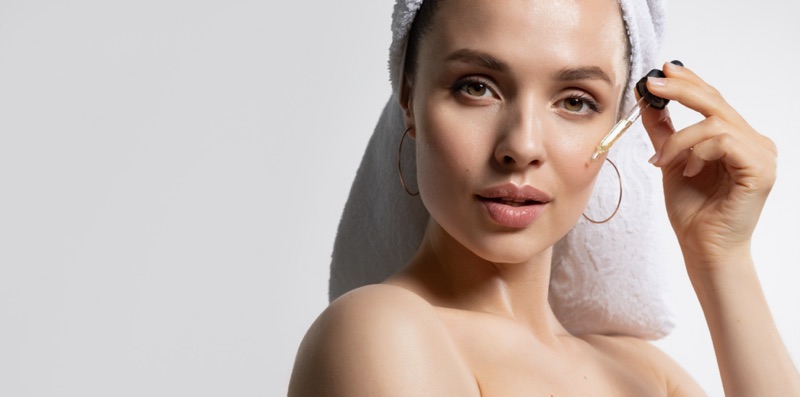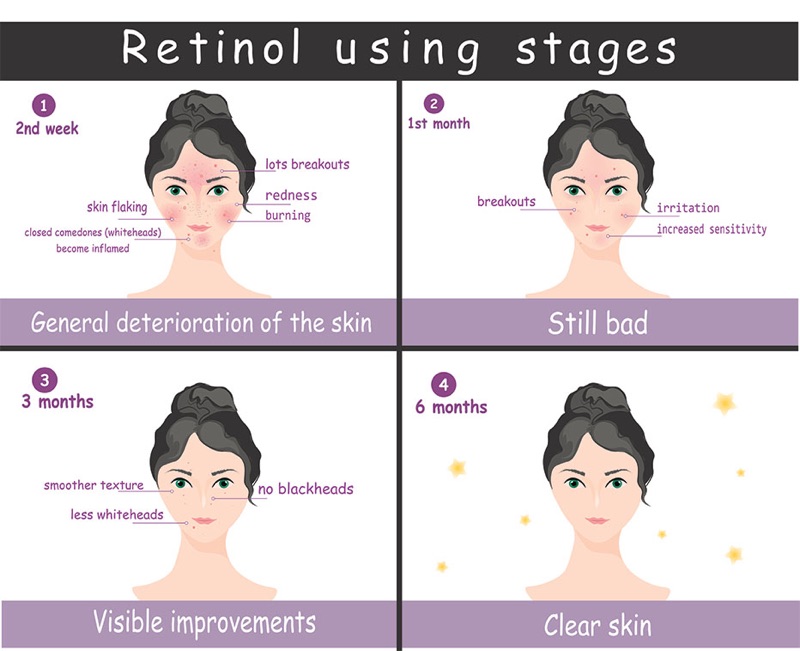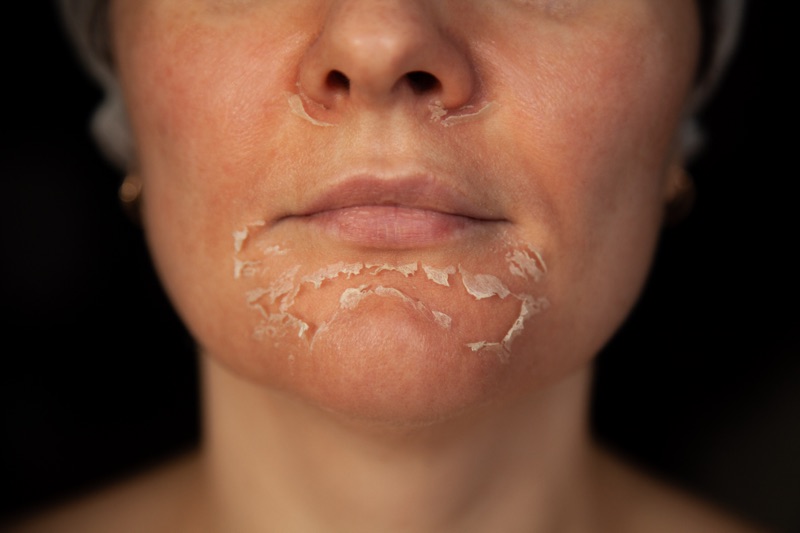Both Azelaic Acid & Retinol contribute a lot to our skin, just in different ways, but can you use them together? The answer is YES! Combining Azelaic acid and Retinol together makes them even stronger.
First, know the power of both ingredients individually
Azelaic Acid & its benefits
- It is an antioxidant naturally found in grains such as wheat, barley & rye.
- Azelaic Acid is basically known to kill bacteria on the skin hence great for acne-prone skin.
- It helps improve brown skin discoloration & Melasma
- Its anti-inflammatory properties make it apt for people with Rosacea.
- Azelaic Acid is very well tolerated by even sensitive skin types and hence can be used every day.

How does Azelaic Acid work on the skin?
- It works wonders in treating acne by decreasing the production of excess Keratin in the skin, a natural substance that can lead to the development of acne and acne-causing bacteria. The excess Keratin can cause the dead skin cells to stick together making them harder to remove. The oils from the sebaceous glands and the dead skin cells can form a blockage in the hair follicle and that’s how acne begins.
- Azelaic Acid exfoliates the skin, promoting healthy new skin growth by stimulating skin cell turnover.
- The antioxidant properties control all the free radicals making the complexion bright and skin texture smooth.
How to apply Azelaic Acid in a skincare routine?
- Wash your face with a cleanser
- Take a pea-sized amount or a few drops of Azelaic Acid
- Massage it evenly on the face & neck
- Layer it with a non-comedogenic moisturizer
How much Concentration of Azelaic acid should be used?
10-20% is well effective & tolerated
Are there any side effects of using Azelaic Acid?
Generally, it is well tolerated by even sensitive skin types but in rare cases, few might face skin Irritation, redness, drying, or mild burning sensations. Stop using it for a while & either consult your Dermatologist or restart with a lower concentration.
When & how many times should you apply Azelaic Acid?
If it’s well tolerated by your skin then, twice a day is recommended, morning-night, if it’s not then once in the morning is good enough. You can find it in a variety of forms like Azelaic acid serum, cream, and mask.
Who should not use Azelaic Acid?
If you have Asthma consult your doctor before using Azelaic acid
Can Pregnant/Nursing women use Azelaic Acid?
Yes, no studies have shown any problems with using Azelaic acid.
What other ingredients is Azelaic acid compatible with?
Lactic acid, Glycolic acid, Retinol, Niacinamide and Hyaluronic acid.
How much time does it take to show results when using Azelaic Acid?
6-8 weeks
Product Recommendations for Azelaic Acid
Here are some of the best products containing Azelaic acid:
1. The Ordinary Azelaic Acid Suspension 10%– It’s a lightweight cream-gel formula that contains 10% Azelaic Acid. The reviews show that it has significantly improved the texture and tone of the skin, making it soft and even. It is suited for even sensitive skin types and is more cost-effective than any other brand. Price: 11.10 USD for 30 ml.
2. Paula’s Choice 10% Azelaic Acid Booster– This formula contains Azelaic acid, Licorice, and Salicylic acid which makes it ideal for acne-prone skin. Salicylic acid and Azelaic acid control oil production, and acne and improves skin texture. Licorice helps diminish post-acne marks. Price: 31 USD for 30 ml.
3. SkinCeuticals Phyto A+ brightening treatment– It is a lightweight oil-free brightening moisturizer that contains 3% Azelaic acid, 2% Alpha Arbutin, 5.75% Phyto botanical blend that targets improvement in post blemish marks, treats dullness and rough skin texture. Price: 105 USD for 30 ml
4. The Inky List Azelaic Acid Serum– This cost-effective mind-blowing Azelaic acid serum is truly amazing. The formula contains 10% Azelaic acid, 0.3% Allantoin, and microfine green-colored particles that combat the redness. It is suitable for all skin types including sensitive skin.
That was all about Azelaic Acid, moving on to the next star-Retinol.
Retinol
Retinol is a bliss to the skin care industry for its multitasking skin power.
It’s a derivative of Vitamin A which is most of the time confused with Retinoids by general people. In the easiest way, Retinol is one of the 7 kinds of Retinoids hence also mild in comparison to the strong Retinoids.

Retinol Benefits
- Boosts Collagen production by speeding cellular turnover to double.
- It is prescribed to treat acne breakouts, acne scars & discoloration of the skin.
- Works wonders for skin aging signs fine lines, sagging skin & wrinkles.
- In short, it slows down aging skin!!
How does Retinol work on the skin?
- The reason it is so freaking popular is, it goes deep into the layers of the skin & exfoliates the clogged pores by eliminating dead skin cells & bacterial growth which ultimately leads to the regeneration of fresh young cells & clean pores which helps ultimately in acne control.

How to apply Retinol in a skincare routine?
- Wash your face with a gentle cleanser
- Pat your face dry completely
- Apply a pea-sized amount or a few drops of Retinol evenly on the face & neck
- Massage gently
- Layer it with a non-comedogenic moisturizer
- Don’t forget your sunscreen the next day!
How much Concentration of Retinol should be used?
.025% – 0.1%, 2-3 times a week. Can go up to 1% gradually when your skin feels ready.
What other ingredients can you safely pair Retinol with?
Niacinamide and Retinol, Azelaic Acid and Retinol, Hyaluronic Acid and Retinol are safe to use in your skincare routine.
How much time does it take to show results when using Retinol?
8-12 weeks
When can you start using Retinol?
The early 20s are just fine with proper precautions
When should you apply Retinol?
Only at nighttime
Who should not use Retinol?
- For pregnant/Nursing women, Retinol is harmful to the baby throughout nursing
- If you have Rosacea-prone skin or Eczema, unfortunately, any retinoids are not a great choice for your skin type. It makes dry skin worse.
The most important tips to take care of when applying Retinol
- Always apply sunblock when you’re out during the day. Using retinol makes your skin highly photosensitive which means the skin is very sensitive to UV light.
- Don’t mix Retinol with any other ingredient except the few I have mentioned above.
- Do not use it very close to your eyes, mouth, or nose. Extra tip, apply Vaseline on the corners of your mouth & around your eyes before applying retinol for extra protection.
- Try & avoid using any other potential irritants like acids or chemical exfoliants when you’re just beginning your retinol journey. This can minimize your burns & excess flaking.
- Use the Sandwich method of ‘moisturizer-retinol moisturizer’, which Means a layer of moisturizer then retinol then moisturizer again. This will prevent any possibilities of irritation.
Product Recommendations for Retinol
Here are some of the best products containing Retinol:
1. Differin Gel – Adapalene is an evidence-based ingredient that is also FDA Approved to treat acne, and repair aging signs of the skin like fine lines and wrinkles with long-term use. Price: 18 USD
2. La Roche Posay Adapalene – Same ingredient- Adapalene with different brand names. Adapalene is a mild form of Retinol compared to Tretinoin or other forms of Vitamin A. Price: 37 USD
3. Avene Retrinal 0.1 intensive – It contains Retinol and Peptides and is one of the soothing retinol formulations which makes it feasible to use even around the eyes. It has some great reviews on curing crows’ feet around the eyes, wrinkles around the mouth and lines on the neck. Price: 74 USD
4. Cereve Resurfacing Retinol– It’s a combination of Retinol, Niacinamide, Licorice root, and Ceramides. This nongreasy gel textured formula is even suited for people with skin conditions like Rosacea. It’s a mild retinol formula compared to other retinol products. Licorice root brightens the skin, niacinamide helps calm the redness of the skin and ceramides strengthen the skin barrier which makes it a brilliant product for everyday use. Price: 23 USD
5. Neutrogena rapid wrinkle repair regenerating cream– This creamy and rich moisturizer is a wrinkle fighter for your skin. The description on its packaging claims that it starts to reduce the appearance of dark spots, wrinkles, and dullness in just one week of usage. Price: 28 USD
What if you get a Burn or skin irritation from applying Retinol or Azelaic acid?

Don’t Panic, your skin will be back to a normal state within a few weeks.
Just take care of these points
- Take cold showers or ice your face (wrapped in a thin cloth). Avoid hot showers at any cost.
- Avoid using scented cleansers or moisturizers.
- Use Thermal spring water to calm the skin (Try from La Roche Posay)
- Don’t use any exfoliating fancy gadgets to wash your face, simply hands.
- Give a lot of moisture & hydration to the skin for it to feel better. Apply moisturizers loaded with ceramides & Hyaluronic acid.
- Now, seal the skin with a light layer of Vaseline. It locks in all the goodies we’ve given & lets the skin heal faster.
- Stop using any other exfoliants, acids, AHAs, BHAs, peroxides, and salicylic acid until you are completely healed.
- Glycerin & Aloe vera, both are great soothing & calming agents for the skin.
- Product suggestion- Try Avene- Cicalfate + restorative protective cream
- Apply sunblock before stepping outside. Remember your skin is already in a vulnerable state. UV rays at this point can make it worse.
Now, what happens when you mix Azelaic acid and Retinol together?
- You get a double dose of brightening! Azelaic acid prevents new melanin production by preventing the activity of tyrosinase enzyme while retinol works on the existing hyperpigmentation, together resulting in even bright skin.
- They are also a solid acne-fighting duo. Retinol cleans pores by going into the deep layer of the skin killing bacterial growth & controlling sebum production while azelaic acid’s antibacterial properties result in killing the bacteria on the surface. It’s a boon for the skin if it can tolerate them together.

How do you apply both Azelaic Acid and Retinol together?
Azelaic acid and Retinol are a very compatible duo. The sequence of application doesn’t matter honestly, but if you ask my preference, I will go with the mild ingredient first hence Azelaic acid goes as the first layer.
- Wash your face with a cleanser
- Pat your face dry
- Apply Azelaic acid & massage it evenly & gently (pea-sized amount)
- Apply Retinol, Massage it gently all over the face & neck (pea-sized amount)
- Layer it with moisturizer & that’s it.
- Don’t forget to apply sunblock the next day!
A few related Articles
If you loved reading this article, you will probably also enjoy reading:
- Can you use Glycolic Acid with Retinol?
- Should you apply Retinol before or After Moisturizer
- Can you use Benzoyl Peroxide with Retinol?
- Can you use Vitamin C with Retinol?
- Can you use Retinol And Hyaluronic Acid Together?
- Can you use Niacinamide with Retinol?
- Can you use Salicylic Acid and Retinol Together?
Hope you have healthy bright skin, Love~ Beauty Stroll